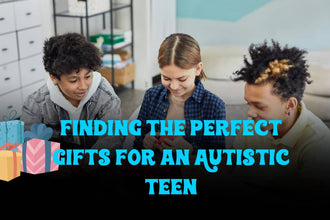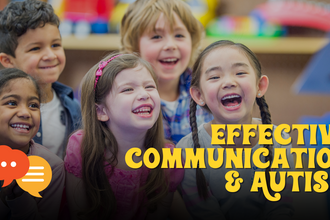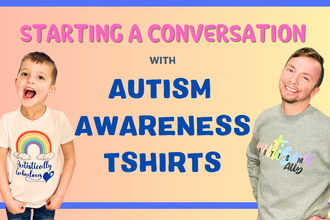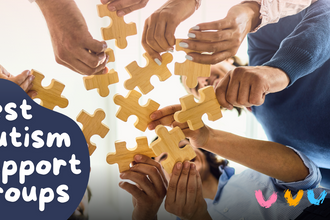
Sometimes the world can be a bit overwhelming with all its sights and sounds. Well, imagine if you felt that way a lot of the time. That’s how some of our friends with autism might feel. But guess what? Books can be like magic portals for them, helping them learn, have fun, and understand others better.
Autism touches many lives, and literature has the power to bridge gaps in understanding. Whether you’re looking to connect with the experiences of autistic individuals or find resources to support a loved one, the right book can open doors to new perspectives. Join us as we explore these thoughtfully selected books and discover how they can enrich our understanding and acceptance of neurodiversity.
Section 1: Importance of Picture Books
Picture books are invaluable for children, whether they're on the spectrum or not. These books are filled with vibrant illustrations and simple stories that make learning enjoyable for all. For children on the spectrum, picture books offer the added benefit of easy readability and relatability. The colorful images and straightforward narratives are designed to capture their attention and aid in comprehension.
They provide a comfortable learning experience that aligns with their preferences. But picture books aren't exclusive to children on the spectrum - they're for everyone! They serve as a tool for better understanding and support, helping all children learn about various emotions, situations, and the world around them.
Section 2: Top 5 Autism Picture Books
1. "Ada Twist, Scientist" by Andrea Beaty
- For Ages: 4-8 years
- Rating: 4.5/5
- Key Points:
- Encourages asking questions and finding answers.
- Shows how fun science can be.
- Teaches that it's okay to be curious.
- Celebrates being different and unique.
In "Ada Twist, Scientist," kids join Ada, a curious girl who loves asking questions and exploring. With colorful pictures and fun stories, the book shows how cool science can be. Ada never gives up on finding answers, teaching kids to be curious and keep trying. It's a great story for all kids, whether they're on the spectrum or not. It helps them learn problem-solving skills and to never stop being curious. As they read about Ada's adventures, children discover the joy of exploring and the importance of curiosity in learning about the world around them.
2. "Stellaluna" by Janell Cannon
- For Ages: 3-7 years
- Rating: 4.7/5
- Key Points:
- Teaches about friendship and acceptance.
- Shows that being different is okay.
- Tells a heartwarming story with beautiful pictures.
- Helps kids understand others who are different from them.
"Stellaluna" tells the story of a bat named Stellaluna who learns about friendship and being herself. With beautiful illustrations and a heartwarming narrative, kids learn about accepting others who are different. Stellaluna's journey helps kids understand that it's okay to be unique. It's a wonderful book for all children, teaching them about kindness and accepting differences. Through Stellaluna's experiences, children learn about empathy and the value of embracing diversity, making the book a timeless classic that encourages acceptance and inclusion.

3. "How to Party Like a Snail" by Naseem Hrab
- For Ages: 3-6 years
- Rating: 4.6/5
- Key Points:
- Shows it's okay to be yourself.
- Teaches that everyone is unique and special.
- Makes learning fun with funny stories.
- Encourages kids to feel good about themselves.
In "How to Party Like a Snail," kids meet a funny snail who learns to be proud of who he is. With silly illustrations and amusing stories, the book celebrates individuality and self-acceptance. It teaches children to embrace their uniqueness and celebrate what makes them special. Suitable for all kids, the story brings laughter and positivity, instilling a sense of belonging and self-confidence. As children giggle along with the snail's adventures, they learn valuable lessons about self-love and embracing their identity, making "How to Party Like a Snail" a delightful read that inspires confidence and acceptance.

4. "The Story of Ferdinand" by Munro Leaf
- For Ages: 4-8 years
- Rating: 4.8/5
- Key Points:
- Tells a story about being true to yourself.
- Shows that it's okay to be different.
- Teaches about kindness and peace.
- Makes kids feel good about who they are.
"The Story of Ferdinand" shares the tale of a bull who loves flowers more than fighting. With simple language and a powerful message, kids learn about staying true to themselves. Ferdinand's peaceful nature encourages kids to embrace their individuality and not conform to others' expectations. It's a book for all children, teaching them about being proud of who they are. Through Ferdinand's story, children discover the importance of staying true to themselves and celebrating their unique qualities, making "The Story of Ferdinand" a timeless classic that inspires self-confidence and authenticity.

5. "A Color of His Own" by Leo Lionni
- For Ages: 3-7 years
- Rating: 4.6/5
- Key Points:
- Teaches about finding your place in the world.
- Shows that everyone is special in their own way.
- Uses beautiful pictures to tell a touching story.
- Helps kids understand and accept others.
"A Color of His Own" follows a chameleon's quest to find where he belongs. With vibrant illustrations and touching storytelling, kids learn about identity and belonging. The chameleon's journey teaches children that it's okay to be different and to find where they fit in. Suitable for all kids, the book emphasizes the importance of self-acceptance and understanding. As children immerse themselves in the chameleon's adventures, they learn valuable lessons about acceptance and diversity, making "A Color of His Own" a heartwarming read that encourages empathy and inclusivity.

Section 3: Value of Reading Books
Reading books holds immense value for children, regardless of whether they're on the spectrum or not. Books provide a gateway to imagination and knowledge, fostering language development and empathy. For children on the spectrum, books offer an accessible means of learning and understanding complex emotions and social cues. The clear and concrete depictions within stories help them navigate the intricacies of social interactions.
Additionally, reading books promotes language skills and cognitive development, benefiting all children in their journey of growth and learning. By delving into the pages of books, children can explore diverse perspectives, broaden their horizons, and develop a deeper understanding of the world around them.
Section 4: Top 5 Autism Reading Books
1. "Benji, the Bad Day, and Me" by Sally J. Pla
- For Ages: 4-8 years
- Rating: 4.5/5
- Key Points:
- Teaches how to handle tough days.
- Helps understand feelings.
- Shows how to keep trying, no matter what.
- Empowers kids to overcome challenges with positivity.
"Benji, the Bad Day, and Me" unfolds the story of Benji as he confronts a challenging day, navigating through setbacks and emotions. Through Benji's journey, children grasp the essence of resilience, understanding that tough times can be overcome. The narrative serves as a beacon of hope, instilling emotional intelligence and coping mechanisms in young readers. By witnessing Benji's experiences, kids learn to identify and manage their own feelings, fostering a sense of empowerment and self-assurance.

2. "Crow Boy" by Taro Yashima
- For Ages: 5-10 years
- Rating: 4.7/5
- Key Points:
- Teaches about making friends and fitting in.
- Shows why kindness is important.
- Helps kids understand and accept others.
- Inspires children to be inclusive and compassionate.
"Crow Boy" delves into the world of Chibi, a boy initially isolated until he discovers friendship and acceptance. The narrative intricately weaves themes of inclusion and belonging, guiding children through the importance of empathy and understanding. As readers accompany Chibi on his journey, they embrace the notion that differences should be celebrated rather than shunned. The book serves as a gentle reminder of the power of kindness and the transformative impact it can have on individuals' lives.

3. "Different Like Me: My Book of Autism Heroes" by Jennifer Elder
- For Ages: 6-12 years
- Rating: 4.8/5
- Key Points:
- Introduces inspiring role models with autism.
- Celebrates diversity and strengths.
- Teaches kids about acceptance and understanding.
- Encourages empathy and appreciation for differences.
"Different Like Me" introduces children to a collection of autistic role models throughout history, celebrating their unique talents and contributions. Through captivating stories, young readers embark on a journey of discovery, learning about neurodiversity and the richness it brings to the world. Each narrative serves as a testament to the importance of embracing differences and appreciating individual strengths. As children immerse themselves in the lives of these extraordinary individuals, they develop a deeper understanding of diversity and inclusion, fostering empathy and acceptance.

4. "All Cats Have Asperger Syndrome" by Kathy Hoopmann
- For Ages: 4-10 years
- Rating: 4.6/5
- Key Points:
- Explains Asperger Syndrome in a simple way.
- Promotes understanding and acceptance.
- Encourages empathy and kindness towards others.
- Helps kids appreciate neurodiversity and differences.
“All Cats Have Asperger Syndrome" employs endearing cat illustrations to demystify Asperger Syndrome in a relatable manner for children. Through charming anecdotes and accessible language, the book sheds light on the unique traits associated with Asperger Syndrome, promoting understanding and acceptance. Young readers embark on a delightful journey of discovery, gaining insight into neurodiversity and celebrating differences. As they explore the world of Asperger Syndrome through the lens of adorable feline companions, children develop empathy and compassion, nurturing a culture of inclusivity and respect for all individuals.

5. "All My Stripes: A Story for Children with Autism" by Shaina Rudolph and Danielle Roye
- For Ages: 4-8 years
- Rating: 4.9/5
- Key Points:
- Follows a zebra with autism on a journey of self-discovery.
- Teaches about acceptance and embracing uniqueness.
- Inspires empathy and compassion in children.
- Encourages kids to celebrate their own and others' differences.
In "All My Stripes," readers accompany Zane, a zebra with autism, as he embarks on a journey of self-discovery and acceptance. Through Zane's experiences, children learn about the importance of embracing diversity and celebrating individuality. The narrative eloquently portrays the challenges and triumphs of navigating the world with autism, fostering empathy and understanding in young readers. As children accompany Zane on his quest for acceptance, they gain valuable insights into neurodiversity and the richness it brings to our communities. "All My Stripes" serves as a poignant reminder that our differences are what make us unique and should be embraced wholeheartedly.

Section 5: Tips for Selecting the right Book
1. Look for Relatable Characters
When picking out books, it's essential to find characters who feel like you do and go through similar experiences. Imagine reading about someone who understands your feelings and struggles—it's like finding a friend in a story! These relatable characters can help you feel connected and understood, making you happier and less alone. They're like companions on your reading journey, guiding you through the ups and downs of life in a way that feels comforting and familiar.
2. Pick Books with Clear Pictures
Books with bright and clear illustrations are like a breath of fresh air. These pictures are easy to see and understand, making it effortless to follow along with the story. They're like windows into the world of the book, helping you visualize the characters and settings as if they were right in front of you. Clear pictures keep you engaged and interested, turning reading into a fun and immersive experience that you'll want to revisit again and again.
3. Let Kids Choose Their Books
Giving autistic children the freedom to choose their books is empowering. It's like handing them the keys to their own adventure, allowing them to take control of their reading journey. When kids have a say in what they read, it makes them feel important and excited about diving into a new story. They're like captains of their own ship, steering themselves towards books that spark their interest and curiosity.
4. Think About How Books Feel
The tactile experience of reading is just as important as the words on the page. Think about how the book feels when you hold it in your hands—is it smooth or rough? Does it have a pleasing texture? Choosing books that feel good to touch can enhance your reading experience, making it more enjoyable and comfortable. It's like finding the perfect spot to curl up with a good book, where every touch brings you closer to the story.
5. Explore Different Topics
The world of books is vast and diverse, filled with endless possibilities. From animals to adventures to space exploration, there's something for everyone to discover. Exploring different topics broadens your horizons and opens your mind to new ideas and perspectives. It's like embarking on a grand expedition, where every page turn leads to a new and exciting destination. So don't be afraid to step outside your comfort zone and explore the unknown—you never know what wonders you might uncover!
Final Verdict
Books hold immense power to transform lives, especially for individuals on the autism spectrum. They serve as invaluable tools for learning, understanding, and connecting with others. Through colorful illustrations, relatable characters, and engaging narratives, books provide a gateway to imagination, knowledge, and empathy. Let's continue to celebrate the magic of literature and empower individuals of all abilities to embark on their own enriching reading journeys.
Become a part of Prideful on the Spectrum's community today where we spread awareness about the diverse spectrum of abilities in autistic individuals. Explore our carefully crafted toys and a clothing line that aims to celebrate differences and challenge stereotypes. Come and join hands in bringing a change- Explore now!








